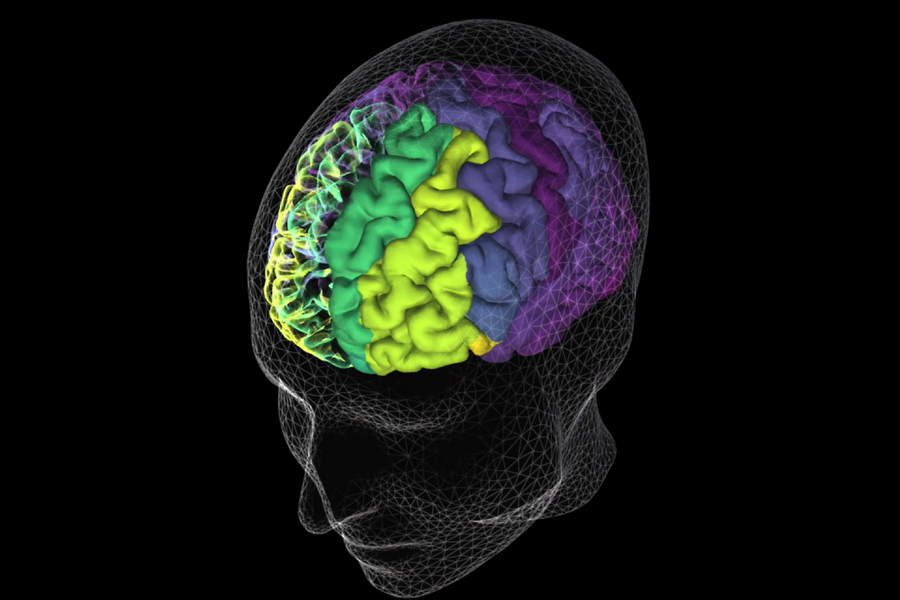What happens in the brain during an argument? An interactive atlas shows active areas during anger, annoyance or despair
On October 6, an exhibition on the subject of quarrels opens at the Museum für Kommunikation. The brain simulation group at the Berlin Institute of Health at the Charité (BIH) is contributing a touch-controlled screen on which feelings that play a role in quarreling become visible: Anger, annoyance, envy or resignation arise in certain networks of the brain, which visitors can specifically light up.

Source: Berlin Institute of Health in der Charité (BIH)
Bernstein member involved: Petra Ritter
From the outside, the brain looks like half a walnut: Deep grooves run through the two halves of the brain, the surface is slightly shimmering, there are also darker areas on the inside, and blood vessels surround the nerve tissue. The incredible variety of tasks and abilities that the brain holds, from the control of movements and the vegetative functions of heartbeat, breathing and digestion to memory and great emotions, is not apparent at first glance.
Making knowledge from databases visible
Petra Ritter and her team from the BIH’s Brain Simulation working group are literally shedding light on this issue: from computer-generated knowledge databases based on more than 35 million scientific articles, they have compiled information about the brain and are making it visible in the simulated brain on the computer. “For the “Strife” exhibition, they searched these literature databases for research papers that deal with related topics such as anger, fear, resentment or despair and the brain,” Petra Ritter tells us. “Because that’s so many papers that no human can read them all, we used a program developed by the Fraunhofer Gesellschaft to do this. Using an extension we developed, we were able to use this program to calculate how strongly a particular feeling is associated with a particular region of the brain: the more often this region is mentioned in connection with the feeling, the more likely it really is to be related to it. We visualized the strength of the association between region and emotion using colors.”
The scientists led by Petra Ritter fed their results into their model, the simulated brain, and then programmed an app: if the visitor now clicks on the term anger, a network consisting of the most strongly associated regions lights up. Now the brain can be turned around and viewed from all sides. Another click on the illuminated region reveals that this is the limbic cortex, the seat of several other emotions. In the case of despair, it also lights up, but in addition the entire prefrontal cortex, a sign that this feeling is associated in the literature with large parts of the brain. In this way, visitors can visualize which networks play a special role in fear, despair, anger and envy, and at the same time learn something about the brainstem, the cerebellum or the hippocampus.
Understanding brain functions and diseases
The diverse information for the simulated brain comes from brain imaging studies such as PET, EEG or MRI, but also from behavioral studies and lifestyle surveys as well as clinical data from thousands of patients as well as healthy controls. The digital twin of the brain allows much more than visualizing emotions during an argument, or brain areas described in scientific literature as being associated with these emotions. Instead of creating pure visualizations of knowledge – as with the exhibition app, scientists can use virtual brains to compute personalized brain simulations. “Our virtual brain enables a large number of researchers to conduct innovative research within a powerful, digital platform and thereby better understand mechanisms of brain function and diseases,” Petra Ritter explains her actual research project. The long-term goal is to improve the diagnosis and prediction of diseases and to optimize therapies using the virtual brain. The BIH scientists are collaborating with many international partners, including contributing to the EU Flagship Human Brain Project and leading the European Open Science Cloud Project Virtual Brain Cloud as well as the EU infrastructure project EBRAIN-Health.
“We are very pleased to be able to contribute to the “controversy” exhibition at the Berlin Museum of Communication. This way we can bring our research to a broad audience in an entertaining way. And in the process, hopefully get them a little excited about the wonder of the human brain.”




